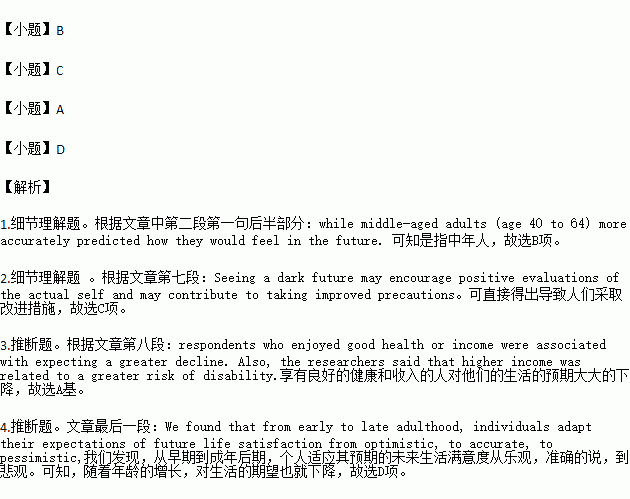题目内容
E
A German study suggests that people who were too optimistic about their future actually faced greater risk of disability or death within 10 years than those pessimists( 悲观者)who expected their future to be worse.
The paper, published this March in Psychology and Aging, examined health and welfare surveys from roughly 40,000 Germans between ages 18 and 96. The surveys were conducted every year from 1993 to 2003.
Survey respondents (受访者) were asked to estimate their present and future life satisfaction on a scale of 0 to 10, among other questions.
The researchers found that young adults (age 18 to 39) routinely overestimated their future life satisfaction, while middle-aged adults (age 40 to 64) more accurately predicted how they would feel in the future. Adults of 65 and older, however, were far more likely to underestimate their future life satisfaction. Not only did they feel more satisfied than they thought they would, the older pessimists seemed to suffer a lower ratio (比率) of disability and death for the study period.
“We observed that being too optimistic in predicting a better future than actually observed was associated with a greater risk of disability and a greater risk of death within the following decade,” wrote Frieder R. Lang, a professor at the University of Erlangen-Nuremberg.
Lang and his colleagues believed that people who were pessimistic about their future may be more careful about their actions than people who expected a rosy future.
“Seeing a dark future may encourage positive evaluations of the actual self and may contribute to taking improved precautions (预防措施),” the authors wrote.
Surprisingly, compared with those in poor health or who had low incomes, respondents who enjoyed good health or income were associated with expecting a greater decline. Also, the researchers said that higher income was related to a greater risk of disability.
The authors of the study noted that there were limitations to their conclusions. Illness, medical treatment and personal loss could also have driven health outcomes. However, the researchers said a pattern was clear. “We found that from early to late adulthood, individuals adapt their expectations of future life satisfaction from optimistic, to accurate, to pessimistic,” the authors concluded.
1.According to the study, who made the most accurate prediction of their future life satisfaction?
A. Optimistic adults.
B. Middle-aged adults.
C. Adults in poor health.
D. Adults of lower income.
2.Pessimism may be positive in some way because it causes people ______.
A. to fully enjoy their present life
B. to estimate their contribution accurately
C. to take measures against potential risks
D. to value health more highly than wealth
3.How do people of higher income see their future?
A. They will earn less money.
B. They will become pessimistic.
C. They will suffer mental illness.
D. They will have less time to enjoy life.
4.What is the clear conclusion of the study?
A. Pessimism guarantees chances of survival.
B. Good financial condition leads to good health.
C. Medical treatment determines health outcomes.
D. Expectations of future life satisfaction decline with age.
 字词句篇与同步作文达标系列答案
字词句篇与同步作文达标系列答案

